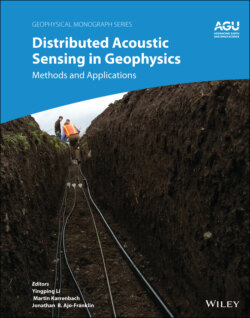Читать книгу Distributed Acoustic Sensing in Geophysics - Группа авторов - Страница 25
1.2.2. DAS Directionality in Seismic Measurements
ОглавлениеIn the previous section, we analyzed the correspondence between DAS and geophones in the one‐dimensional case and found that “geophone‐style” velocity data can be extracted from DAS signals by spatial integration. However, in 3D analysis, we should consider that DAS is not a velocity sensor but a differential strain sensor. This is a fundamental difference: DAS can measure a component of 3D tensor (strain) but not 3D vector (velocity).
Directionality of the DAS response depends on the fiber optic cable configuration and the cable design, as the device itself is sensitive only to fiber elongation. We will start our consideration where the fiber is placed linearly inside a cable, with no slippage between fiber and cable, nor between the cable and the ground. In this case, fiber displacement will follow ground displacement, and sensitivity will depend on the relative position of fiber and seismic source. A similar mechanical principle was used for the electromagnetic linear strain seismograph to measure variations in the distance between two points of the ground (Benioff, 1935). DAS directional response with respect to incident angle Γ can be found by transformation of the strain tensor components with rotation using geometrical consideration. For a longitudinal (P) apparent wave, it will be cos2Γ, and for transversal (S) wave sin Γ cos Γ, similar to Benioff (1935) (see Figure 1.14). Detailed analysis and diagrams for Rayleigh and Love waves can be found in Martin et al. (2018).
In vertical seismic profiling (VSP), in the vertical part of the well, both cable and seismic waves are in the same direction for near‐offsets, so the DAS is more sensitive to P‐waves, in which the acoustic displacement vector coincides with the fiber direction. In other applications, such as fracking, the microseismic source is usually on a side of the cable, so shear waves can be effectively detected.
Cable orientation is responsible not only for acoustic amplitude but also for acoustic spatial resolution, even for the same acoustic wavelength. The cable acts as an acoustic antenna where the signal varies rapidly in space if the P‐wave and cable direction coincide, but the signal remains the same over distance if the acoustic wave front is parallel to the cable. To take this effect into consideration, we need to expand the expression for acoustic wavelength Kz along the cable for Equations 1.29–1.30 as:
(1.31)
For a harmonic wave, directionality will directly affect not only the spatial resolution but also the temporal frequency. After Fourier transfer in the time domain, Equation 1.30, in the absence of aliasing, can be presented as:
(1.32)
Figure 1.14 DAS with linear optical cable is more sensitive to P‐wave in VSP configuration and to S‐wave in microseismic events.
Figure 1.15 2D spectral representation on upgoing and downgoing acoustic waves: The left panel represents original signal and the right panel represents filtered signal, where the spatial filter shape is shown by a blue wavy line.
This expression (Equation 1.32) represents spatial filtering in the 2D Fourier domain as shown in Figure 1.15 for L0 = 10m for upgoing and downgoing waves, together with white phase noise. As far as harmonic waves can be represented as single lines, the result of spatial filtering is an intensity modulation of these lines. Such modulation is equivalent to temporal frequency modulation, so we can combine Equation 1.31 and Equation 1.32 to get:
(1.33)
It is interesting to mention that, for uniform strain, where C → ∞, we have |ℑA(F)| ∝ cos2Γ as expected from Benioff (1935). The result of modeling of Equation 1.33 is presented in Figure 1.16 for different incident angles. An increase in angle expands the measurement frequency range but reduces low‐frequency SNR at the same time.
DAS directivity can be significantly modified through appropriate cable design, which is currently a developing area. For example, field tests have shown that the helical placement of fiber within a squeezable material can deliver omnidirectional sensitivity (Hornman et al., 2013) for P‐waves. The angular dependence will be different for S‐waves (Abbott et al., 2019), and a different helix pitch can be useful to optimize performance for different wave types (Baird, 2020). Additional complexity comes from cable construction, and the Poisson′s ratio of the cable itself can affect the angular signature (Wuestefeld & Wilks, 2019). An even more sophisticated approach can be used to measure inertial acceleration—by using a dedicated non‐isotropic cable, where a dense mass compresses the fiber along the cable (Farhadiroushan et al., 2017). Such a solution can be used for multi‐component seismic acquisition, including for analysis of microseismic events.
Figure 1.16 Normalized SNR curve (SNR vs. frequency) for a 3000 m/s wave speed of P‐wave at 0° and 45° incident angles.
This analysis demonstrates that the DAS broad spectral response can potentially correspond to conventional geophones and seismometers. In the next section, we will provide some examples of how such promises can be fulfilled in field measurements.
